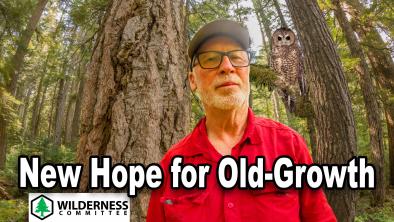Canada’s last breeding pair of endangered spotted owls found in valley slated for imminent logging
The Narwhal

The federal government is legally obliged to respond to an Ecojustice petition calling for an emergency order to stop logging in the Spuzzum Valley, where two rare chicks hatched this year
Environmental law charity Ecojustice is petitioning the federal government to step in and halt logging in B.C.’s Spuzzum Valley, where a spotted owl pair with chicks has been found after the species was presumed extinct in Canada.
Ecojustice, which submitted the petition on Wednesday calling for an emergency order to be issued under Canada’s Species at Risk Act, said it only recently learned of the existence of the breeding pair, discovered in 2019 by B.C. government biologists.
The northern spotted owl pair hatched one chick last year, and two chicks this year, according to Ecojustice, which is acting on behalf of the Vancouver-based conservation group Wilderness Committee.
Two chicks — one each year — were removed from the nest and taken to a government-funded breeding facility for endangered spotted owls in Langley, Wilderness Committee protected areas campaigner Joe Foy told The Narwhal. Government biologists planned to remove the third chick by this fall, Foy said.
“It’s extremely alarming to see rare old-growth forests being logged in Spuzzum Valley, home to the last remaining breeding pair of spotted owls in Canada,” he said.
“As we speak, there’s a block of old-growth forest that has been felled. There’s a crew in the block and they are yarding the trees out and loading them onto logging trucks.”
Two more Spuzzum Valley cut blocks, auctioned off by the government agency BC Timber Sales, are slated for logging in the near future, said Foy, who has been documenting road-building and clear-cutting in endangered spotted owl habitat in the Fraser Canyon, including in the Spuzzum Valley.

Spuzzum First Nation Chief James Hobart said the provincial government should have told the nation about the breeding pair when the active nest was first discovered.
“It’s either a really gross oversight or it’s intentional,” he said in an interview.
“The powers that be knew about it … And now something really needs to be done. Not only to stop the logging immediately and completely [but] there has to be some accountability for the government to be taking chicks out of a wilderness nest.”
“This information should have come out a long time ago. They’ve been aware of it and they’ve allowed the logging to go on.”
Ecojustice is demanding that federal Environment Minister Jonathan Wilkinson take immediate steps towards implementing emergency order protections for spotted owls and their habitat.
Under the Species at Risk Act, Wilkinson can ask cabinet to issue the emergency order on the grounds that the species faces imminent threats to its survival and recovery. That would allow Ottawa to make decisions normally within the jurisdiction of the B.C. government, including whether or not to allow logging in the Spuzzum Valley.
“Decades of provincial mismanagement have left spotted owls without legal protection and decimated the old-growth forests where they once lived,” Ecojustice lawyer Kegan Pepper-Smith said.
“Without federal emergency action, there is a high likelihood that this species will disappear from the wild in the near future.”
Spotted owls hatched in B.C. laboratory but not released into wild
Spotted owls have all but vanished from B.C., the only place they were found in Canada. Biologists estimate there were once 1,000 spotted owls in southwestern B.C.’s old-growth forests of Douglas fir, western hemlock and western red cedar.
Today, following the destruction and fragmentation of much of their habitat, only three spotted owls are known to exist in the province’s wild. Until the breeding pair was discovered in the Spuzzum Valley, the three were thought to be individuals with no offspring.
“The northern spotted owl is back from the dead in Canada — where once there was a flat line there is now a shimmer of hope,” Foy said. “What Canada does next in the way of protecting habitat may just tip the balance in favour of life.”
In the mid-2000s, following a push from the federal government to take action to protect spotted owls, the B.C. government funded the establishment of an experimental breeding program in Langley, which The Narwhal visited in 2018.
There, spotted owl eggs are incubated in a laboratory called Artificial Inc. and hatch while a playlist of spotted owl calls and forest bird song rolls in the background. The hatchlings are fed morsels of rat muscles offered on tweezers and, once deemed healthy, they are placed in a nest with their parents or foster parents.
Three chicks were born this year in the lab, while a record five chicks hatched last year. The centre houses 25 adult owls, including seven breeding pairs, in outdoor aviaries.
The B.C. government has repeatedly said captive-bred spotted owls will be re-introduced to the wild. But not a single captive-bred owl has been released since the breeding program began more than a decade ago.
Pepper-Smith said the Spuzzum Valley spotted owl pair represents the only proven option for maintaining the wild population, given there is no evidence that owls raised at the breeding facility can be successfully introduced to the wild.
“This is the last known breeding pair — and I think it’s hard to over emphasize how important it is that they continue to survive and breed,” Pepper-Smith said in an interview.
“This emergency order would get the federal government involved to say: ‘Enough is enough. You need to prohibit any further logging within this watershed, to help ensure this pair continues to live.’ ”
Ecojustice has given the federal government until the end of November to respond.
‘We will do whatever we can to protect them’
Chief Hobart said his nation will hold a ceremony to welcome home the spotted owls, which are sacred and appear in myths passed down from one generation to another. “They were the owls that were spoken of,” he said. “It’s really a struggle for us to know that this is happening out there.”
“To know that one of our owls that is part of our heritage, part of our stories, is still amongst us, it’s really going to be a very exciting time.”
He said the nation will defend the owls, “taking it on the ground if we have to.”
“Now that we know they’re there, we will do whatever we can to protect them.”
In June, The Narwhal reported that the B.C. forests ministry issued more than 300 logging approvals — totalling almost 2,000 hectares — in the spotted owl’s range between October 2018 and May 2020.
Foy said the Spuzzum Valley cutblocks were approved before October 2018.
He said there is a designated wildlife habitat area in the lower portion of the Spuzzum Valley, some of it old-growth, that has been set aside for spotted owls. But “spotted owl habitat doesn’t work like islands,” Foy pointed out.
“Spotted owl habitat, in times past, allowed owls to fledge and move over the landscape. BC Timber Sales is literally cutting down any possibility of that, of any connecting forest. They are literally pulling apart the landscape in a way that makes it very difficult for owls to survive without human intervention.”
Emergency order should protect remaining habitat: Ecojustice
The spotted owl was listed as endangered under the federal Species at Risk Act (SARA) in 2003, requiring Ottawa to take action to recover populations.
A 2006 federal recovery strategy for the spotted owl committed to producing an action plan within a year to identify the raptor’s critical habitat and activities likely to destroy it.
But B.C., which is responsible for developing the habitat action plan, still hasn’t produced it.
“Since that time, successive B.C. governments have talked the talk but have refused to walk the walk,” Pepper-Smith said.
In 2006, with fewer than two dozen spotted owls remaining in the wild, Environment Canada officials recommended to then-federal Environment Minister Rona Ambrose that a SARA emergency order be issued.
In response, the B.C. government committed to protecting all occupied spotted owl sites, to enhance the population, and to institute broader habitat identification and protection.
Pepper-Smith said the commitments satisfied Ambrose that there was no longer an imminent threat to the species’ survival and recovery.
But many of B.C.’s commitments have not been fulfilled, Pepper-Smith said.
“Owls in cages in the captive breeding program is not ‘survival’ or ‘recovery’ as contemplated by SARA,” Ecojustice said in the letter to Wilkinson that accompanied the petition.
An emergency order should, at a minimum, protect the habitat required to ensure the survival of the last remaining breeding pair of spotted owls in Canada, the letter said.
Chief Hobart said instead of approving logging in spotted owl habitat the B.C. government should honour the owls on the provincial stage and show it is “sticking up for these endangered species: ‘We’re taking it seriously, we’re stopping all logging. We’re notifying people of the boundaries’ … all of those things that matter to the ecosystem of these owls.”
In May 2019, Ecojustice sent a letter on behalf of Wilderness Committee to then-Environment Minister Catherine McKenna, demanding that her ministry publish the long-awaited action plan to identify spotted owl critical habitat — a plan by then 12 years overdue.
In response, McKenna committed to prioritize completion of “an updated, SARA-compliant recovery document for the spotted owl in the shortest feasible timeframe.”
‘About more than the fate of two singular birds
Pepper-Smith said the document has stalled, ostensibly due to the COVID-19 pandemic and the need to consult with First Nations. A draft updated recovery strategy is now set to be completed in the summer of 2021.
But that could be too late for the breeding spotted owl pair, according to Ecojustice and Wilderness Committee.
“It’s just inevitable that this particular breeding pair goes the way that the rest of the population has gone, and is either directly or indirectly impacted from continued logging activity, and eventually dies,” Pepper-Smith said. “And then we’re left with no more owls in the wild.”
The B.C. government is not responding to media questions during the election period, unless they pertain to public health and safety information or statutory requirements.
” … as the province with the largest number of different species, B.C. has much to lose.”
Unlike six other provinces, B.C. does not have stand-alone legislation to protect spotted owls and other endangered species. The NDP government promised to enact such legislation during the 2017 election campaign — a pledge upheld in Premier John Horgan’s mandate letter for Environment Minister George Heyman.
But the party later reneged on its commitment.
Endangered species legislation is not mentioned in the 2020 NDP election platform, released on Oct. 6. Instead, the party vaguely says if re-elected it will “work with neighbouring jurisdictions to cooperatively develop and invest in new strategies aimed at better protecting our shared wildlife and habitat corridors.”
The about-face on endangered species legislation comes as scientists around the world warn we are witnessing the sixth mass extinction event in the planet’s four-billion-year history. Scientists estimate as many as half of all species may be headed toward extinction in the next 30 years, largely due to habitat destruction.
“This letter is about more than the fate of two singular birds,” Pepper-Smith said. “Globally, plants and animals are disappearing at an alarming rate — and as the province with the largest number of different species, B.C. has much to lose.”
“When provinces fail, the law requires the federal government to step up. Inaction — especially in a biodiversity crisis — is not an option. If they neglect to do so, we stand to suffer an incalculable loss.”
Click here to view the original article published by The Narwhal.


